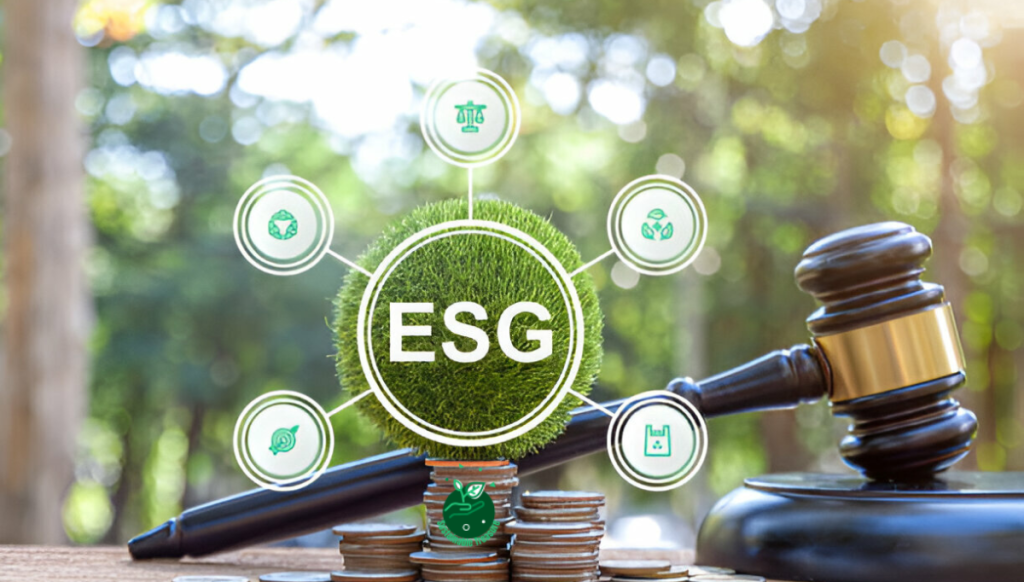Table of Contents
Are you struggling to navigate and do comparing ESG ETFs and determine which one aligns best with your values and investment goals? Fret not, for I have been on a similar quest to find the perfect ESG ETF that resonates with my ethical principles.
During my university days, I witnessed firsthand the devastating impact of unethical corporate practices on local communities.
This experience ignited a fire within me to be a conscientious investor, steering my hard-earned savings towards companies that prioritize sustainability and social responsibility.
However, deciphering the intricacies of ESG investing was no easy feat, and I found myself drowning in a sea of data and complex metrics.
In this article, we’ll explore some of the top ESG ETFs, evaluating their performance, holdings, and suitability for different investment goals.
iShares ESG Aware MSCI USA ETF (ESGU)

Overview
The iShares ESG Aware MSCI USA ETF (ESGU) is one of the largest and most popular ESG ETFs, tracking the MSCI USA Extended ESG Focus Index. This ETF aims to provide exposure to companies with positive environmental, social, and governance characteristics while maintaining a risk and return profile similar to the broader U.S. equity market.
| Pros | Cons |
|---|---|
| Large and well-diversified portfolio | Relatively high expense ratio compared to some other ESG ETFs |
| Broad exposure to U.S. equities | Sector biases (overweight in technology, underweight in energy) |
| Strong track record and liquidity | Some controversial holdings may not align with all investors’ values |
Performance and Holdings
As of May 2024, the ESGU ETF had over $25 billion in assets under management and held positions in over 300 U.S. companies. Its top holdings included technology giants like Apple, Microsoft, and Amazon, as well as healthcare and consumer staples companies.
While the ETF has generally performed well, tracking the broader U.S. market, it may not be the best choice for investors seeking more stringent ESG screening or sector-specific exposure.
Xtrackers MSCI USA ESG Leaders Equity ETF (USSG)
Overview
The Xtrackers MSCI USA ESG Leaders Equity ETF (USSG) is another popular option in the ESG ETF space. It tracks the MSCI USA ESG Leaders Index, which includes companies with high ESG ratings relative to their sector peers.
| Pros | Cons |
|---|---|
| Stricter ESG screening criteria | Relatively smaller and less liquid compared to larger ETFs |
| Sector diversification | Higher expense ratio |
| Excludes companies with controversial business involvement | Limited exposure to some sectors (e.g., energy, utilities) |
Performance and Holdings
As of May 2024, the USSG ETF had over $2 billion in assets under management and held positions in around 300 U.S. companies.
Its top holdings included companies like Microsoft, Visa, and Procter & Gamble. While the ETF’s performance has been solid, its stricter ESG screening criteria may result in a different sector allocation compared to broader market ETFs.
Vanguard ESG U.S. Stock ETF (ESGV)
Overview
The Vanguard ESG U.S. Stock ETF (ESGV) is a low-cost option for investors seeking ESG exposure in the U.S. equity market. It tracks the FTSE Russell US All Cap Fair Index, which screens companies based on ESG criteria and excludes those involved in certain controversial business activities.
| Pros | Cons |
|---|---|
| Low expense ratio | Relatively new ETF with a shorter track record |
| Broad exposure to U.S. equities | Sector biases (underweight in energy and utilities) |
| Excludes controversial business involvement | Limited ESG data availability for smaller companies |
Performance and Holdings
As of May 2024, the ESGV ETF had over $4 billion in assets under management and held positions in over 1,500 U.S. companies.
Its top holdings included technology giants like Apple, Microsoft, and Amazon, as well as healthcare and consumer staples companies. While the ETF’s performance has been solid since its inception, its relatively short track record may be a consideration for some investors.
Nuveen ESG U.S. Aggregate Bond ETF (NUBD)
Overview
For fixed-income investors seeking ESG exposure, the Nuveen ESG U.S. Aggregate Bond ETF (NUBD) is an option worth considering. This ETF tracks the Bloomberg Barclays MSCI US Aggregate ESG Select Index, which includes U.S. investment-grade bonds while applying ESG screening criteria.
| Pros | Cons |
|---|---|
| Exposure to investment-grade U.S. bonds | Limited track record |
| ESG screening criteria applied to bond holdings | Relatively higher expense ratio compared to some non-ESG bond ETFs |
| Diversification benefits for equity-heavy portfolios | Sector biases (underweight in energy and utilities) |
Performance and Holdings
As of May 2024, the NUBD ETF had over $1 billion in assets under management and held positions in various U.S. investment-grade bonds. Its top holdings included bonds from the technology, financial, and consumer sectors.
While the ETF’s performance has been solid since its inception, its relatively short track record and higher expense ratio compared to some non-ESG bond ETFs may be considerations for some investors.
FlexShares STOXX US ESG Impact Index Fund (ESG)
Overview
The FlexShares STOXX US ESG Impact Index Fund (ESG) is a unique ETF that focuses on companies with positive ESG characteristics and those generating revenue from products and services that address ESG themes.
| Pros | Cons |
|---|---|
| Exposure to companies driving positive ESG impact | Relatively higher expense ratio |
| Thematic approach to ESG investing | Limited exposure to certain sectors |
| Diversification benefits for traditional equity portfolios | Relatively smaller and less liquid compared to larger ETFs |
Performance and Holdings
As of May 2024, the ESG ETF had over $500 million in assets under management and held positions in around 150 U.S. companies. Its top holdings included companies in the technology, healthcare, and industrial sectors. While the ETF’s performance has been solid, its thematic approach and higher expense ratio may not appeal to all investors.
FAQs

What Is The Best ESG ETF?
There is no definitive “best” ESG ETF as the ideal choice depends on an investor’s specific goals, risk tolerance, and personal values.
However, some of the top-rated ESG ETFs based on factors like assets under management, expense ratio, and performance include the iShares ESG Aware MSCI USA ETF (ESGU), the Vanguard ESG U.S. Stock ETF (ESGV), and the Xtrackers MSCI USA ESG Leaders Equity ETF (USSG).
It’s crucial to evaluate each ESG ETF’s underlying holdings, sector allocations, and screening methodologies to ensure alignment with your investment objectives and ethical considerations. Additionally, factors like expense ratios, liquidity, and track records should be taken into account.
Are ESG ETFs Worth It?
ESG ETFs can be a worthwhile investment for socially conscious investors seeking to align their portfolios with their values and beliefs.
By investing in companies with strong environmental, social, and governance practices, ESG ETFs can potentially mitigate risks associated with unethical or unsustainable business practices while promoting positive change.
However, the potential for outperformance or underperformance relative to traditional benchmarks is debated, and investors should carefully evaluate the trade-offs, such as potentially higher fees or sector biases.
Ultimately, the decision to invest in ESG ETFs depends on an investor’s personal motivations, risk tolerance, and investment goals.
What Is The ESG Score Of An ETF?
An ESG score is a numerical rating assigned to an ETF or its underlying holdings based on their performance across various environmental, social, and governance factors.
These scores are calculated by independent research firms or rating agencies using proprietary methodologies that evaluate companies’ practices and policies related to issues such as carbon emissions, waste management, labor relations, board diversity, and corporate governance.
ESG scores are typically expressed on a scale, with higher scores indicating better ESG performance. However, the specific scoring systems and criteria used can vary across different rating agencies, making it important for investors to understand the methodology behind the scores when evaluating and comparing ESG ETFs.
How Do You Compare Two ETFs?
Comparing two ETFs involves evaluating several key factors to assess their suitability for your investment goals and risk tolerance. Here are some important considerations:
- Investment objective and strategy: Ensure that the ETFs align with your investment objectives, whether it’s broad market exposure, sector-specific focus, or a particular investment style (e.g., growth, value, or ESG).
- Holdings and diversification: Analyze the ETFs’ underlying holdings, sector allocations, and geographic exposure to understand the level of diversification and potential concentration risks.
- Performance and risk metrics: Compare historical performance, volatility, and risk-adjusted return measures (e.g., Sharpe ratio, Sortino ratio) to assess the ETFs’ risk-reward profiles.
- Expenses and fees: Evaluate the expense ratios, trading costs, and any other fees associated with the ETFs, as these can significantly impact long-term returns.
- Liquidity and trading volume: Consider the ETFs’ average daily trading volume and bid-ask spreads to ensure sufficient liquidity for efficient trading.
- Tracking error and replication method: For index-tracking ETFs, assess the tracking error and replication method (physical or synthetic) to understand how closely the ETF follows its underlying index.
By thoroughly analyzing these factors, investors can make informed decisions and choose the ETF that best aligns with their investment objectives and risk tolerance.
What Metrics Are Used To Compare ETFs?
Several key metrics are commonly used to compare and evaluate ETFs:
- Expense ratio: This measures the annual fees charged by the ETF as a percentage of its assets under management. Lower expense ratios are generally preferred as they can significantly impact long-term returns.
- Performance metrics: These include returns over various time periods (e.g., 1-year, 3-year, 5-year), as well as risk-adjusted measures like the Sharpe ratio, Sortino ratio, and alpha.
- Tracking error: For index-tracking ETFs, the tracking error measures how closely the ETF’s performance follows its underlying index.
- Liquidity and trading volume: Average daily trading volume, bid-ask spread, and premiums/discounts to net asset value (NAV) are used to assess an ETF’s liquidity and trading efficiency.
- Portfolio metrics: Investors may analyze the ETF’s sector allocations, geographic exposure, market capitalization breakdown, and concentration in top holdings to understand the level of diversification and potential risks.
- ESG scores and ratings: For ESG-focused ETFs, investors evaluate the underlying companies’ ESG scores and ratings provided by independent research firms or rating agencies.
- Replication method: For index-tracking ETFs, the replication method (physical or synthetic) can impact tracking error, counterparty risk, and tax implications.
By considering these metrics, investors can gain a comprehensive understanding of an ETF’s characteristics, performance, risks, and suitability for their investment objectives.
What Are The Largest ESG ETFs?
As of May 2024, some of the largest ESG ETFs by assets under management (AUM) include:
- iShares ESG Aware MSCI USA ETF (ESGU) – $25 billion AUM
- Vanguard ESG U.S. Stock ETF (ESGV) – $4 billion AUM
- Xtrackers MSCI USA ESG Leaders Equity ETF (USSG) – $2 billion AUM
- FlexShares STOXX US ESG Impact Index Fund (ESG) – $500 million AUM
- Nuveen ESG U.S. Aggregate Bond ETF (NUBD) – $1 billion AUM
It’s important to note that AUM is not the sole determinant of an ETF’s quality or performance. Investors should also consider factors such as the ETF’s investment strategy, holdings, expense ratio, and track record when evaluating ESG ETFs, regardless of their size.
Who Controls ESG Scores?
ESG scores and ratings are typically assigned by independent research firms or rating agencies that specialize in evaluating companies’ environmental, social, and governance practices. Some of the prominent organizations that provide ESG scores and ratings include:
- MSCI ESG Research
- Sustainalytics
- ISS ESG
- Bloomberg ESG Data Service
- Refinitiv ESG Scores
These organizations use proprietary methodologies and data sources to assess companies’ ESG performance across various factors, such as carbon emissions, waste management, labor relations, board diversity, and corporate governance. They then assign numerical scores or ratings to companies based on their evaluations.
While there are no universally accepted standards for ESG scoring, these organizations aim to provide objective and transparent assessments to help investors integrate ESG considerations into their investment decisions. It’s important for investors to understand the specific methodologies and criteria used by different rating agencies when evaluating and comparing ESG scores and ratings.
How Do I Monitor ETF Performance?

Monitoring the performance of your ETF investments is essential to ensure they continue to align with your investment goals and risk tolerance. Here are some strategies to help you track and evaluate your ETF holdings:
- Review periodic performance reports: Most ETF providers offer online tools or mobile apps that allow you to track the performance of your ETF holdings over various time periods (e.g., daily, monthly, quarterly, annually).
- Set up portfolio tracking: Use portfolio management software or online tools to consolidate your ETF holdings and monitor their performance, asset allocations, and associated fees.
- Analyze key performance metrics: Evaluate metrics such as returns, volatility, Sharpe ratios, and tracking errors to assess the ETF’s risk-reward profile and how closely it follows its underlying index.
- Monitor news and analyst reports: Stay informed about market developments, regulatory changes, or any significant events that may impact the performance or underlying holdings of your ETFs.
- Review periodic rebalancing: Regularly review your portfolio to ensure that your ETF allocations align with your target asset allocation and risk tolerance, and rebalance as needed.
- Consult with a financial advisor: If you have a complex portfolio or specific investment goals, consider working with a qualified financial advisor who can provide personalized guidance and monitoring for your ETF investments.
By regularly monitoring your ETF performance and staying informed about market developments, you can make informed decisions and adjustments to ensure your investments remain aligned with your objectives.
How To Analyze An ETF?
Analyzing an ETF is a crucial step in determining whether it aligns with your investment goals, risk tolerance, and investment strategy. Here’s a general approach to analyzing an ETF:
- Understand the investment objective and strategy: Review the ETF’s prospectus or factsheet to understand its investment objective, underlying index (if applicable), and the methodology used for selecting and weighting its holdings.
- Evaluate the portfolio composition:
- Review the ETF’s top holdings and sector/industry allocations to understand the level of diversification and potential concentration risks.
- Assess the market capitalization breakdown (large-cap, mid-cap, small-cap) and geographic exposure to ensure alignment with your investment goals.
- For sector or thematic ETFs, evaluate the underlying companies’ exposure to the targeted theme or industry.
- Analyze performance and risk metrics:
- Review the ETF’s historical performance over various time periods (1-year, 3-year, 5-year, etc.) and compare it to relevant benchmarks.
- Evaluate risk-adjusted performance measures like the Sharpe ratio, Sortino ratio, and alpha to assess the ETF’s risk-reward profile.
- Analyze volatility metrics, such as standard deviation and maximum drawdown, to understand the potential for fluctuations in returns.
- Consider costs and fees:
- Examine the ETF’s expense ratio, which represents the annual management fees and other operational costs as a percentage of assets under management.
- Evaluate any additional costs, such as trading commissions or bid-ask spreads, which can impact the overall cost of ownership.
- Assess liquidity and trading volume:
- Review the ETF’s average daily trading volume and bid-ask spreads to ensure sufficient liquidity for efficient trading.
- For thinly traded ETFs, consider the potential impact of wider bid-ask spreads on your trading costs.
- Understand the replication method (if applicable):
- For index-tracking ETFs, determine whether the ETF uses physical replication (holding the underlying securities) or synthetic replication (using derivatives or swaps).
- Evaluate the potential risks and implications associated with each replication method.
- Consider the ETF provider and track record:
- Research the ETF provider’s reputation, experience, and overall product lineup.
- Review the ETF’s inception date and track record, particularly for newer or more specialized ETFs.
- Align with your investment objectives and risk tolerance:
- Assess whether the ETF’s investment objective, risk profile, sector exposure, and other characteristics align with your overall investment goals and risk tolerance.
- Consider how the ETF fits within your broader portfolio and asset allocation strategy.
By thoroughly analyzing these factors, you can make an informed decision about whether a particular ETF is a suitable investment option for your portfolio.
Conclusion
Choosing the right ESG ETF depends on various factors, including your investment goals, risk tolerance, and personal values.
While some ETFs offer broad exposure to ESG-focused companies, others take a more targeted approach, focusing on specific sectors or themes. Additionally, factors such as expense ratios, liquidity, and track records should be considered when evaluating ESG ETFs.
Ultimately, investors should thoroughly research and understand the methodologies and holdings of different ESG ETFs to ensure alignment with their investment objectives and ethical considerations. Regular portfolio review and rebalancing may also be necessary as the ESG landscape evolves and new opportunities arise.



